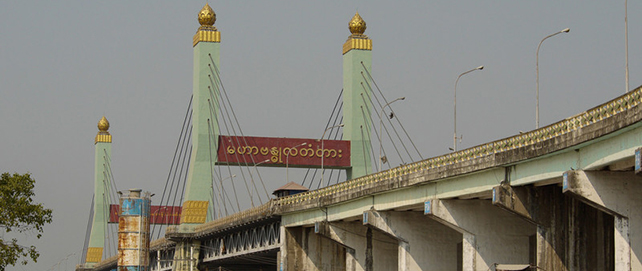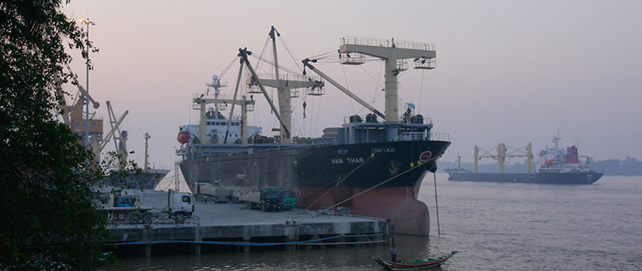





Having emerged from decades of political and economic isolation, Myanmar is well on its way toward achieving economic growth and poverty reduction. With abundant natural resources, a youthful population, and a strategic location at the crossroads of Asia, the country has huge development potential. Elections held in November 2015 were an important milestone in the country’s transition to democracy. The country is an active partner in GMS economic cooperation, with widespread reforms now under way to support broad-based, inclusive, and sustainable socioeconomic development. Myanmar’s reintegration into the global economy presents unique opportunities for leveraging private sector growth to reduce poverty, share prosperity, and sustain the nationwide peace process. As Myanmar has been buoyed by a positive performance in recent years, combined with a raft of new social and economic policies and increased investments in infrastructure, health, education, and rural development, the outlook for its economy remains positive.
Quick Facts
| Population | 54.82 million (2020) |
| Average Annual Population Growth Rate | 0.9% (2015-2020) |
| GDP at PPP (current international dollars) | 264.1 billion (2020) |
| GDP per capita at PPP (current international dollars) | 4,861 (2020) |
Agriculture
With its large land area, fertile soil, and abundant water resources, Myanmar has great potential to become an agricultural powerhouse. Farming is the backbone of the economy, employing approximately 70% of the country’s labor force and providing a major source of export earnings. GMS partners, especially the PRC and Thailand, are key markets for Myanmar’s wide range of produce, including mainstays such as rice and maize. Increased agricultural productivity and profitability is a core national strategy for poverty reduction and food security. Sector priorities include improving food processing, storage, transportation and logistics facilities; scaling up irrigation; increasing access to financial, marketing, research, and extension services; developing high-quality seeds; and attracting greater foreign investment.
Energy
Myanmar is well positioned to increase its energy-generation capacity due to its abundant resources, especially water (for hydropower) and natural gas. Energy exports to other GMS countries and farther afield make a huge contribution to the national economy. The government has prioritized energy access for rural households as an essential aspect of the country’s development, with the goal of universal energy access by 2030. Other priorities include promoting energy efficiency and conservation and scaling up renewable energy programs, such as solar mini-grids and micro-hydropower projects.
Environment
Myanmar is endowed with extensive forest, freshwater, and marine resources, as well as significant minerals, precious stones, oil, and gas. Often referred to as “the last frontier of biodiversity in Asia,” the country boasts a huge array of fauna and flora species. Myanmar has established a range of biodiversity priorities that includes forest restoration; the expansion of protected areas, including mangrove forests; the development of management plans for ecosystem-based fisheries; and the fight against illegal fishing in the Myeik Archipelago. Myanmar has also established a set of procedures for evaluating the environmental impact of development projects, one of many new initiatives to better balance environmental sustainability against the country’s recent rapid economic growth.
Human Resource Development and Health
Myanmar’s National Education Strategic Plan (NESP) sets out a road map for the transformational reform of the country’s education system. The NESP emphasizes universal access to preschool and basic education, and makes a clear commitment to improving the quality of education through reforms of the curriculum, teacher education, and student assessment. Another priority is improving the quality of both higher education and technical and vocational education and training. Myanmar has also made significant gains in public health in recent years. Malaria mortality rates are down, infant and maternal health have improved, and immunization coverage has increased. In 2017, a new national health plan was launched that prioritizes universal health care as an integral part of Myanmar’s road to sustainable growth and poverty reduction. Additional priorities include enhancing health sector capacity, controlling disease, and promoting healthy lifestyles.
Information and Communication Technology
Internet and mobile phone use has increased rapidly in Myanmar over the past 5 years, with investments continuing to improve access to ICT. Since the government reformed the telecommunications sector in 2014, the number of internet users is estimated to have increased rapidly from 2 million to more than 39 million, according to official figures. Network providers are now rolling out 4G connectivity and enhancing mobile applications for banking and financial technology, business, agriculture, and health services. Initiatives such as these are expected to create more affordable telecom services across the country and to boost economic growth and job creation.
Tourism
Among the country’s many wonders are the spectacular pagodas of Yangon, Bagan, and Mandalay; the numerous unspoiled beaches and islands in the south; and the stunning landscapes around Inle Lake. As an emerging destination, the country is working hard to develop the policies and infrastructure needed to lay a firm foundation for sustainable tourism growth. The country’s tourism master plan has prioritized the strengthening of Myanmar’s brand as a quality tourist destination and the provision of better training for workers in the tourism sector.
Transport
Since 2004, Myanmar has added 10,000 kilometers of major roads, in addition to expanding its railway network. Road improvements along key economic corridors have helped connect Myanmar with its GMS partners to the east, and with India to the west. As Myanmar is a strategic bridge between South Asia and Southeast Asia, improving the quality and connectivity of its transport infrastructure is vital for the country’s development and for that of the wider GMS region. With support from its GMS partners, Myanmar is looking to scale up infrastructure investments to enhance its roads, railways, seaports, and airports.
Transport and Trade Facilitation
Nearly two-thirds of Myanmar’s trade is within the GMS, with the PRC and Thailand as its most important trading partners. These two countries provide a wide range of imports to Myanmar and purchase a major share of its petroleum, mineral, and agricultural exports. Myanmar and Thailand are focusing efforts on a bilateral agreement to reduce the time, costs, and paperwork associated with cross-border transport. Myanmar is also rolling out an automated system for customs clearance, and is working on a “single-window” system for trade documentation. Myanmar is also exploring possibilities for strengthening trade linkages with GMS partners through the development of special economic zones.
Urban Development
Approximately one in three people in Myanmar lives in urban areas. Infrastructure in the country’s two largest cities, Yangon and Mandalay, and in many other towns is in need of rehabilitation. Increasing urbanization is placing additional pressure on urban planning, housing, transport systems, and municipal management. The country is working with international partners and investors to modernize major cities, regional centers, and towns along the GMS economic corridors. Priorities include upgrading public services and utilities, creating more public spaces, and conserving cultural heritage sites.
GMS Program Officials and Contacts in Myanmar
- Dr. Marlar Myo Nyunt
National Coordinator
Director General
Foreign Economic Relations Department
Ministry of Investment and Foreign Economic Relations - Daw Moh Moh NAING (Ms)
Focal Person
Director
Foreign Economic Relations Department
Ministry of Planning and Finance - GMS National Secretariat
Focal Person
International Organizations (IO) section
Foreign Economic Relations Department
Ministry of Investment and Foreign Economic Relations
Greater Mekong Subregion: 25 Years of Partnership
